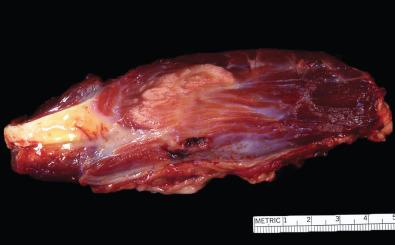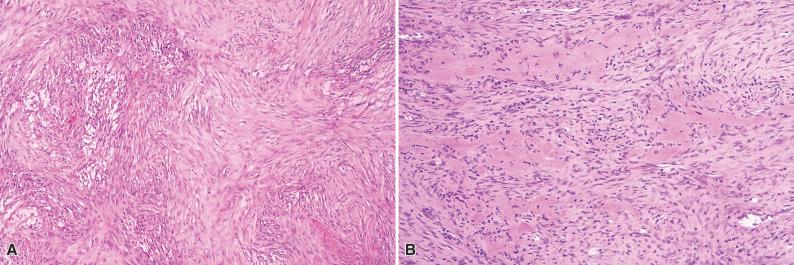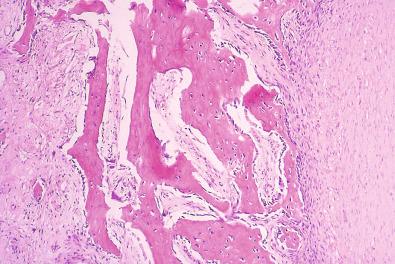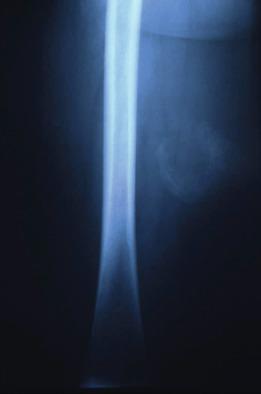Physical Address
304 North Cardinal St.
Dorchester Center, MA 02124
Soft tissue tumors and other mass-forming lesions exhibiting osteocartilaginous differentiation are commonly encountered in diagnostic soft tissue pathology. They comprise diverse entities with distinct clinicopathologic features and clinical behaviors. However, it is important to remember that, occasionally, nonmesenchymal tumors may also display osseous and cartilaginous differentiation. Hence, to avoid diagnostic errors, a systematic approach to such tumors is advisable. The following simple four-step algorithm can be helpful ( Box 14.1 ).
Step 1. Confirm the presence of osteocartilaginous differentiation. It is not unusual to confuse hyalinized collagen with osteoid or a myxoid matrix with cartilage. Admittedly where one draws the line between hyalinized collagen and osteoid at the histologic level is a subjective and highly controversial matter, especially considering that both matrices are primarily composed of type I collagen. Some subtle histologic clues may be helpful. The identification of calcification (with a basophilic appearance) rather than a purely eosinophilic matrix or the presence of plump plasmacytoid cells (osteoblasts) surrounding this eosinophilic matrix supports the presence of osteoid or bone formation. Nonetheless it is worth noting that plump osteoblasts are primarily seen in association with metaplastic bone (e.g., fracture callus) and not with neoplastic bone (e.g., osteosarcoma). SATB2 is a nuclear transcription factor required for osteoblastlineage commitment. Recent studies have demonstrated that immunohistochemistry for SATB2 may be useful to confirm osteoblastic differentiation in soft tissue tumors; however, nuclear staining for SATB2 is not entirely specific. In addition, chondrocytes express S-100 protein, and immunohistochemistry for S-100 protein is useful for the confirmation of cartilaginous differentiation, although this marker is also expressed by other cell types.
Step 2. Exclude a primary bone tumor extending into surrounding soft tissue. In most cases, this can easily be assessed by reviewing radiologic studies or obtaining additional clinical information. Furthermore, some bone tumors have unique histologic features that can easily be differentiated from primary soft tissue tumors.
Step 3. Exclude a nonmesenchymal tumor showing osteocartilaginous differentiation. For example, heterologous osseous or cartilaginous differentiation can be seen in a subset of metaplastic carcinomas of the breast and other anatomic sites. In addition, osteocartilaginous differentiation is common in myoepithelial and mixed epithelial-myoepithelial tumors (e.g., pleomorphic adenoma of salivary gland; chondroid syringoma). In such instances, recognition of the (myo)epithelial component by morphologic or immunohistochemical analysis is necessary.
Step 4. Distinguish primary osseous and cartilaginous soft tissue tumors from soft tissue tumors showing secondary (heterologous) osteocartilaginous differentiation. The latter tumor types are discussed in detail elsewhere in this book; the most important considerations for differential diagnosis are briefly mentioned at the end of this chapter. For example, a retroperitoneal sarcoma showing osseous or cartilaginous differentiation is most likely a dedifferentiated liposarcoma. This chapter provides a detailed discussion of primary soft tissue tumors and lesions with osteocartilaginous differentiation.
Confirm that there is indeed bone or cartilaginous differentiation. Hyalinized collagen and myxoid matrix with retraction artifact may simulate bone and cartilage, respectively.
Exclude an underlying bone lesion with secondary soft tissue involvement (review radiologic studies if appropriate).
Exclude a nonmesenchymal tumor showing heterologous osteocartilaginous differentiation.
Differentiate between primary soft tissue tumors with osteocartilaginous differentiation and soft tissues tumors in which osteocartilaginous differentiation is a secondary phenomenon.
Myositis ossificans, also known as myositis ossificans circumscripta , is an apparently nonneoplastic soft tissue lesion that occurs more commonly during the second and third decades of life, usually in physically active individuals. These lesions show a male predilection and most commonly occur within the skeletal muscles of the lower extremities, especially the thighs and buttocks ( Fig. 14.1 ). However, similar processes can also occur in adipose tissue (panniculitis ossificans) or fascia (fasciitis ossificans). In more than 50% of cases, a history of trauma is elicited; pain is a common and early complaint. A lesion indistinguishable from myositis ossificans has also been reported in the mesentery.

Heterotopic ossification is considered by some a synonym for myositis ossificans, perhaps a more mature, later phase of the latter process. Others consider heterotopic ossification an aberrant chondro-ossification of soft tissues caused by a variety of distinct disorders. McCarthy and Sundaram have provided a comprehensive review of the subject.
Histologically, myositis ossificans is a generally well-circumscribed lesion characterized by a central cellular spindle cell area, composed of (myo)fibroblasts with nodular fasciitis–like features associated with immature woven bone formation ( Fig. 14.2 ). Toward the periphery, the lesion displays more organized and mature lamellar bone formation ( Fig. 14.3 ). This progressive maturation from the center to the periphery is classically known as a “zoning” phenomenon and is essentially diagnostic of myositis ossificans. Foci of cartilage undergoing endochondral ossification are also commonly seen. Other findings include cystic degeneration, hemorrhage, and the presence of multinucleated osteoclast-like giant cells as well as other chronic inflammatory cells. The histologic features are nicely mirrored by the radiologic findings, which show a characteristic shell of bone with ring-like features and central lucency ( Fig. 14.4 ), usually after 3 to 4 weeks of evolution . As such, myositis ossificans is usually diagnosed at the radiologic level. Histologic analysis is typically required for sizable lesions or lesions with unusual radiologic features or clinical evolution.



Currently there is no role for immunohistochemistry or genetic analysis for the diagnosis of myositis ossificans. By immunohistochemistry, the spindle cell component can express muscle-specific actin or smooth muscle actin.
The most important differential diagnosis for myositis ossificans is extraskeletal osteosarcoma. In contrast to myositis ossificans, extraskeletal osteosarcoma tends to occur in older patients and does not exhibit a “zoning” phenomenon; bone formation in extraskeletal osteosarcoma is more randomly distributed. Furthermore, marked nuclear pleomorphism and hyperchromasia are typical of extraskeletal osteosarcoma and should not be seen in myositis ossificans. Cystic degeneration and hemorrhage in myositis ossificans simulate the histologic features of soft tissue aneurysmal bone cyst. Fracture callus can occasionally be mistaken for myositis ossificans. This problem can easily be solved by good radiologic correlation (see earlier discussion).
Myositis ossificans is a benign and self-limited condition. Surgery is usually not necessary except when secondary complications arise. Malignant transformation in myositis ossificans has been reported but remains a debatable subject.
Typically found in younger individuals.
Tends to contain areas similar to nodular fasciitis in the lesional center and progressive bone formation and maturation toward the periphery (“zoning” phenomenon).
Review radiologic studies; they are diagnostic in most instances.
Exclude extraskeletal osteosarcoma, which is highly atypical and pleomorphic, does not show the “zoning” phenomenon, and is primarily found in older adults.
Fibro-osseous pseudotumor of the digits (FOPD), also known as florid reactive periostitis or a form of bone surface heterotopic ossification, is a poorly understood condition that closely simulates myositis ossificans. FOPD more commonly occurs around the proximal phalanx of the fingers of young women. Toes can sometimes be affected. Whether FOPD is reactive or neoplastic in nature remains controversial. Clinically, FOPD presents as a painful swelling of the subcutaneous tissues of the involved digit that simulates a neoplasm.
Histologically, FOPD is composed of a cytologically bland spindle cell proliferation with nodular fasciitis–like features associated with immature woven bone formation in a somewhat disorganized fashion ( Fig. 14.5 ). No zoning pattern is seen. Some authorities believe that the lesion is related to bizarre parosteal osteochondromatous proliferation (BPOP), which is among the most important differential diagnoses (see section “ Differential Diagnosis ”).

FOPD has no distinctive immunohistochemical or molecular genetic signature.
The most important differential diagnosis for FOPD is BPOP, which is also attached to the bone surface and has recently been shown to be neoplastic in nature. In contrast to FOPD, BPOP is characterized by a hypercellular cartilaginous cap that matures into trabecular bone. The chondrocytes are enlarged and can be atypical, closely simulating the atypical chondrocytes in chondrosarcoma. However, a typical feature of BPOP is the presence of a peculiar basophilic calcification similar to that seen in aneurysmal bone cyst (“blue bone”) at the junction between the cartilaginous cap and the trabecular bone. Osteosarcoma (skeletal and extraskeletal) is another important diagnostic consideration but shows a much higher degree of cytologic atypia and pleomorphism. In addition, osteosarcoma is rare in the distal extremities. Subungual exostosis shows characteristic radiologic features and often displays a cartilaginous component that matures into trabecular-like bone.
FOPD follows a benign clinical course but can recur locally. Surgical excision is the primary treatment.
As its name implies, FOPD is primarily located in the distal extremities.
FOPD shows nodular fasciitis–like features and disorganized metaplastic bone formation.
FOPD should be differentiated from bizarre parosteal osteochondromatous proliferation. Radiologic studies are paramount.
Fibrodysplasia ossificans progressiva (FOP) is a rare autosomal dominant disorder characterized by several skeletal malformations and progressive extraskeletal aberrant chondro-ossification. The clinical onset of FOP commonly occurs before the fifth year of life. The progressive soft tissue chondro-ossification develops initially around the upper paraspinal muscles and progresses distally and centripetally to the extremities.
The histologic features of FOP are relatively nonspecific and characterized by an initial fibroblastic proliferative phase that evolves over time to an aberrant ossification of muscles, adipose tissue, fascia, tendons, and other structures.
FOP has recently been found to be caused by a constitutive activating mutation of the activin A receptor gene ( ACVR1 ; R206H), which encodes for bone morphogenetic protein type I receptor. This leads to aberrant signaling of this pathway and resultant progressive ectopic soft tissue osteochondrogenesis. Recently, hypoxic signaling via HIF-1α has been implicated in the development of both FOP and nonsyndromic heterotopic ossification.
The differential diagnosis of FOP is varied and includes any benign soft tissue osteocartilaginous lesion. A high degree of suspicion and a detailed clinical history are among the most important tools for reaching the correct diagnosis of FOP.
Currently there is no specific treatment for FOP, and various attempts at pharmacologic approaches have shown limited success. The disease is progressive and ultimately leads to respiratory insufficiency and death due to involvement of the thoracic cage.
Despite the fact that tumoral calcinosis is not primarily a bone- or cartilage-forming lesion, it is included in this chapter because it closely simulates osteocartilaginous tumors.
Tumoral calcinosis is a nonneoplastic condition characterized by periarticular tumor-like calcium deposits most commonly surrounding the major joints, especially the hips, shoulders, and elbows. Unfortunately the nomenclature regarding tumoral calcinosis is confusing, and different authors adopt different classification schemes. Overall, tumoral calcinosis can be familial or sporadic, or it may occur as a secondary manifestation of a number of diseases or conditions (discussed further on). In the latter situation, the deposits can be referred to as tumoral calcinosis–like lesions to differentiate them from primary or familial tumoral calcinosis. Patients typically present during the first two decades of life and the lesions are often multicentric and bilateral. Tumor calcinosis is more common in black males.
Become a Clinical Tree membership for Full access and enjoy Unlimited articles
If you are a member. Log in here